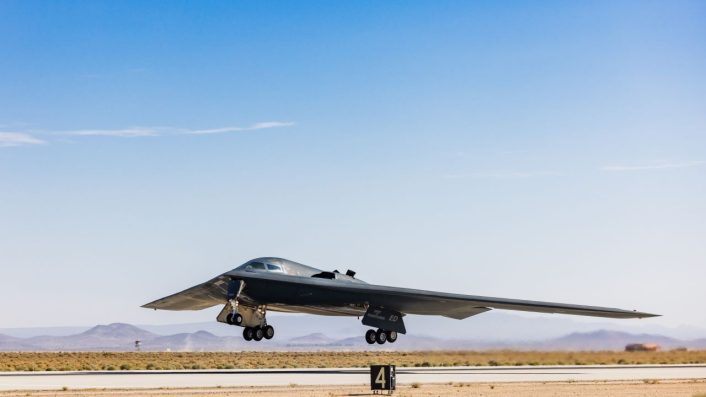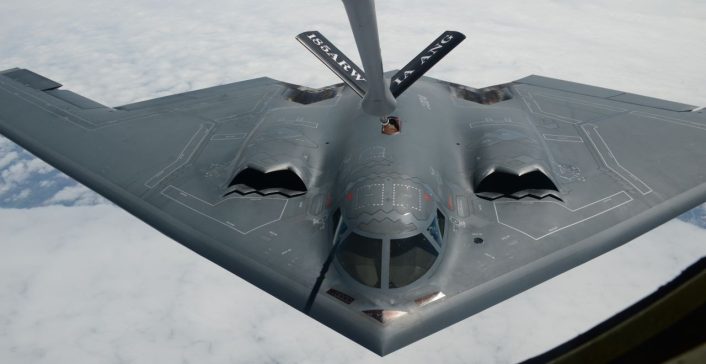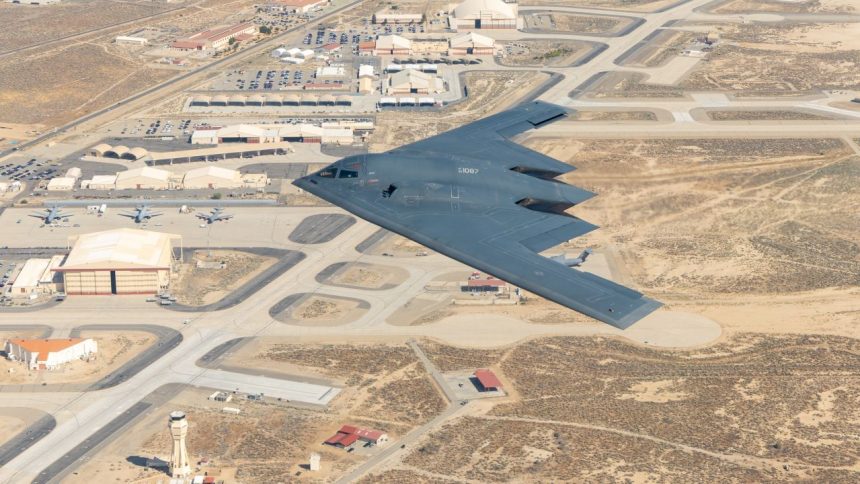The upgrades involve integrating open mission systems architecture, new software, sensors and weapons to enhance the B-2’s survivability and combat capability.
Thirty-five years after the B-2 Spirit stealth bomber first took off from the Air Force Plant 42 in Palmdale, California, to fly to Edwards Air Force Base, the iconic aircraft returned to the military facility on the same date on Jul. 17, 2024. Similarly to what is happening now with the B-21, the B-2 underwent an extensive flight test campaign at Edwards AFB.
Officially released photos show the B-2 nicknamed “Spirit of Pennsylvania” (serial number 93-1087) flying over Edwards and landing there. The mainstay of the Air Force’s long-range conventional and non-conventional airborne strategic strike roles, the B-2 Spirit will be upgraded to remain “competitive” at least until the early-2030s, when it is planned to be replaced by the B-21 Raider.
The last time the “Spirit of Pennsylvania” was at the location was between 2017 and Sep. 2020, when it underwent its scheduled Programmed Depot Maintenance (PDM) at Plant 42 and was then transferred to the 412th Test Wing/419 Test Squadron as the base’s new platform for B-2 flight testing, a statement from the Air Force Global Strike Command said at the time. During PDMs, the B-2s receive an exhaustive inspection of all electrical, mechanical systems along with a complete removal and reapplication of its radar-evading materials to restore its LO (Low Observable) features.
NEWS: The #USAF B-2 returns to test on 35th birthday. This will allow new experiments and technological upgrades to ensure the @AFGlobalStrike fleet remains ready in an era of #GlobalPowerCompetition.
More- https://t.co/r2iwBGzPyK@AFTestCenter @HQ_AFMC @AFLCMCofficial pic.twitter.com/Vp1fiFaU9q
— Edwards Air Force Base (@EdwardsAFB) August 26, 2024
The first B-2 rolled out of its hangar from Plant 42 on Nov. 22, 1988 and flew for the first time on Jul. 17, 1989. Northrop Grumman’s Plant 42 is the birthplace of all the Air Force’s 21 B-2 Spirits, of which 19 are still in service, where they also undergo their scheduled PDMs every nine years.
At Plant 42 this time, the B-2 will undergo a new round of upgrades and testing called Spirit Realm 1, involving the integration of an open mission systems architecture, new software, sensors and weapons, to enhance the B-2’s survivability and combat capability.
B-2s to get even more lethal
The Spirit of Pennsylvania’s return “to the heart of the Aerospace Testing Universe, where many firsts for technological advancements take place is not only nostalgic, but a careful first step toward new experiments and technological upgrades that will ensure it remains a vital asset in the U.S. Air Force’s fleet,” said the Air Force. The Director of Operations with the 419th FLTS, Maj. Stephen Henderson, flew the B-2 back to Edwards on its anniversary.
In addition to functional upgrades, a focus for the new campaign will be testing the integration of the Spirit Realm 1 open mission systems architecture. “This is the first time that we are going to do agile software development with Spirit Realm, so that is a big change for us,” said Henderson.
Spirit Realm 1 provides mission critical capability upgrades to the communications and weapons systems via an open mission systems architecture, directly enhancing combat capability and allowing the fleet to initiate a new phase of agile software releases.

The War Zone reported that one of the weapons that the software and hardware upgrades SR1 might support is the Air Force’s new 2,267 kg-class GBU-72/B bunker-buster bomb. This essentially comprises a BLU-138/B bomb – also known as the Advanced 5,000 Pound Penetrator, or A5K – combined with a Joint Direct Attack Munition (JDAM) family GPS-assisted guidance kit.
The GBU-72 was created to address the challenges of targeting deeply buried hardened structures and is suitable for both fighter jets and bombers, with lethality expected to be significantly higher than that of older weapons like the GBU-28. First tested in 2021 on the F-15E Strike Eagle, the bomb was spotted in March 2024 during testing on the B-1B Lancer bomber on external hardpoints.
As The Aviationist reported, during this year’s RIMPAC (Rim of the Pacific) exercises, the B-2 Spirit also employed the QUICKSINK during the second SINKEX (Sinking Exercise), striking a large, retired naval vessel. QUICKSINK is a low-cost, air-delivered method for neutralizing surface vessels.
It is believed that the B-2 employed a GBU-31/B JDAM, that utilizes the kit’s existing GPS-assisted INS (Inertial Navigation System), a new radar seeker and an IIR (Imaging Infrared) camera for the strike. The B-2’s ability to carry 16 GBU-31 JDAMs highlights the significant anti-surface firepower a single stealth bomber can bring to the sea – a critical capability for a war with China in the western Pacific.
US Air Force B-2 Spirits taxi on runway at Whiteman Air Force Base in Missouri on April 15.
Whiteman Air Force Base executed a mass fly-off of 12 B-2 Spirits to cap off annual Spirit Vigilance exercise. https://t.co/J4oJorhi3C pic.twitter.com/Jc3TXJsEwe
— Ryan Chan 陳家翹 (@ryankakiuchan) April 18, 2024
Critical need before peer rivals
“Regenerating flight test is an exciting time for the B-2 as we begin fielding new capabilities through the B-2 Spirit Realm software factory ecosystem and work hand in hand through the Combined Test Force,” said Jerry McBrearty, vice president and B-2 program manager, Northrop Grumman. “The agile framework methodology within SR 1 directly supports the Air Force’s initiative to adapt new capabilities in the aircraft, executing the mission today.”
The B-2’s improvements are needed before emerging challenges in an era of Global Power Competition, said the Air Force, and demonstrate the commitment to maintaining technological superiority and ensure that the aircraft remains competitive in modern warfare. The fact the U.S. Air Force leadership agreed to part with a B-2 Spirit from its small fleet shows the importance of the upgrade in general and long-range strategic bombing capability in particular.
“It’s a very big deal that higher levels in Air Force leadership decided we would be able to get the test jet back because the B-2 has a small fleet dynamic,” Maj. Henderson said. “So the fact that they were willing to give up one of their jets to do test really speaks to the importance of what we are looking to accomplish and hopefully get those new capabilities out to the warfighter as quickly as possible.”
The testing will be conducted by a CTF (Combined Test Force), consisting of the 419th FLTS, AFOTEC (Air Force Operational Test and Evaluation Center), and the B-2’s developer, Northrop Grumman. “This aircraft enables Operational Test to integrate test points alongside our 412th TW and 53rd WG teammates and serves as another opportunity to conduct integrated tests. It is imperative that we continue to modernize, survive, and test that aircraft up until it is formally relieved from that obligation,” Col. Joseph Little, commander of AFOTEC Detachment 5 at Edwards, said.
The CTF will also continue to partner with the Defense Contract Management Agency in support of the B-2 Phase Depot Maintenance program at nearby Air Force Plant 42. As the world’s only operational stealth long-range penetrating bomber, the B-2 Spirit has a strategic commitment to the United States for years to come.










